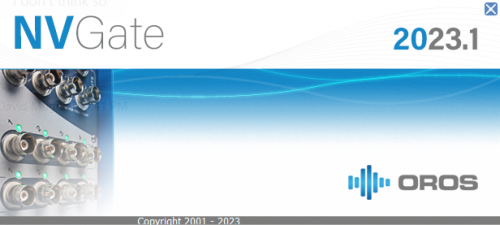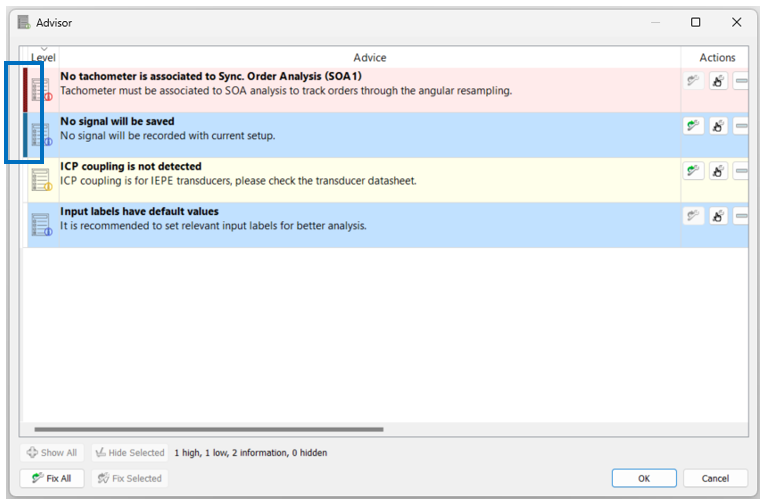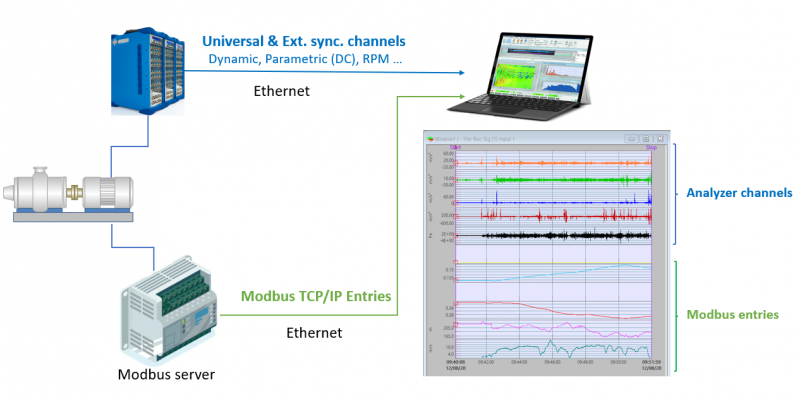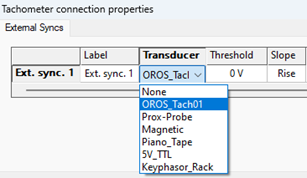Difference between revisions of "NVGate 2023: Release note"
| (26 intermediate revisions by 2 users not shown) | |||
| Line 12: | Line 12: | ||
The [[NVGate V16: Install Process|NVGate® 2023 (V16)]], which is compatible with our latest hardware [[OR3X Hardware Instruments|O4]] and new solution [[Monitoring Solution|Monitoring]], became available in February 2023. | The [[NVGate V16: Install Process|NVGate® 2023 (V16)]], which is compatible with our latest hardware [[OR3X Hardware Instruments|O4]] and new solution [[Monitoring Solution|Monitoring]], became available in February 2023. | ||
The NVGate® 2023.1 major version became available in November 2023. This release of the OROS 3-Series analyzer’s software platform brings additional functionalities and significant performance improvements. Below is a summary of the main enhancements of your NVGate experience:<br> | The NVGate® 2023.1 (V16.10) major version became available in November 2023. This release of the OROS 3-Series analyzer’s software platform brings additional functionalities and significant performance improvements. Below is a summary of the main enhancements of your NVGate experience:<br> | ||
| Line 38: | Line 38: | ||
To download and install NVGate 2023.1, [[NVGate_2023:_Install_Process|check this page]]. | To download and install NVGate 2023.1, [[NVGate_2023:_Install_Process|check this page]]. | ||
<br><br> | <br><br> | ||
Compatibility: NVGate 2023 is compatible with | [[NVGate_2023:_Release_note#Compatibility|Compatibility*]]: NVGate 2023 is compatible with the following OROS instruments: O4 - OR34 - OR10 - OR35 TW - OR36 TW - OR38 TW. Depending on the hardware options and version, some instrument features may or may not be available. | ||
| Line 54: | Line 54: | ||
With '''NVGate ADVISOR''', the metrology watchdog developed with OROS know-how accumulated over 40 years, you will always be accompanied by a noise and vibration expert. | With '''NVGate ADVISOR''', the metrology watchdog developed with OROS know-how accumulated over 40 years, you will always be accompanied by a noise and vibration expert. | ||
You are doing '''impact testing'''? Check out this step-by-step guide!<br> | |||
<youtube>https://youtu.be/qIoZNEcy_K4</youtube> | <youtube>https://youtu.be/qIoZNEcy_K4</youtube> | ||
You are doing '''rotating machine analysis'''? Check out this video!<br> | |||
<youtube>https://youtu.be/mK5_RFjIZhU</youtube> | |||
| Line 64: | Line 72: | ||
When one or more issues are detected, the user will be notified immediately by the “Advisor” icon in the “Home” tab and “Analysis” tab, <br> | When one or more issues are detected, the user will be notified immediately by the “Advisor” icon in the “Home” tab and “Analysis” tab, <br> | ||
[[File:Advisor_1_1.png | [[File:Advisor_1_1.png]] | ||
or by the icon at the lower right corner of NVGate. <br> | or by the icon at the lower right corner of NVGate. <br> | ||
| Line 79: | Line 87: | ||
[[File:advisor_blue.png|40px]] '''Suggestion ''' (blue): It might not be a mistake, but probably a negligence. <br> | [[File:advisor_blue.png|40px]] '''Suggestion ''' (blue): It might not be a mistake, but probably a negligence. <br> | ||
=== Explanation and suggestion === | === Explanation and suggestion === | ||
Click on the Advisor icon, and the Advisor window will be opened. The bar in the beginning means that this Advice is new and unread. In each Advice, the explanation of the detected issue is given, and corresponding solution or suggestion is proposed to assist the user to set up properly and obtain correct measurements. Based on the information, the user can decide to fix the issue or ignore it. <br> | Click on the Advisor icon, and the Advisor window will be opened. The bar in the beginning means that this Advice is new and unread. In each Advice, the explanation of the detected issue is given, and corresponding solution or suggestion is proposed to assist the user to set up properly and obtain correct measurements. Based on the information, the user can decide to fix the issue or ignore it. <br> | ||
[[File:advisor_window.png | [[File:advisor_window.png]] | ||
=== Actions === | === Actions === | ||
| Line 101: | Line 107: | ||
Advisor works in both online and post analysis modes, helping user to properly set up NVGate efficiently. The majority of current Advices are for the application of impact testing and rotating machine analysis, and more Advices covering a wider range of applications will be available in the future NVGate versions. <br> | Advisor works in both online and post analysis modes, helping user to properly set up NVGate efficiently. The majority of current Advices are for the application of impact testing and rotating machine analysis, and more Advices covering a wider range of applications will be available in the future NVGate versions. <br> | ||
== [[File:modbus_resize.png|70px]] Modbus TCP/IP client add-on compatibility == | == [[File:modbus_resize.png|70px]] Modbus TCP/IP client add-on compatibility == | ||
The new '''Modbus TCP/IP''' client add-on is available now. It reads entries from Modbus server and injects the data to NVGate in '''real-time'''. <br> | The new '''[[Modbus_TCP/IP_to_NVGate|Modbus TCP/IP]]''' client add-on is available now. It reads entries from Modbus server and injects the data to NVGate in '''real-time'''. <br> | ||
[[File:modbus-drawing.png| | [[File:modbus-drawing.png|800px]] | ||
The add-on reads from Modbus server the entries which are synchronized with '''dynamic / parametric / Ext. sync.''' channels acquired from OR3X analyzer, and reinjects the entries to NVGate in real-time using simulated DC channels. These values are then managed as DC data in NVGate. The entries can be saved as '''properties''' of projects / measurements automatically. They can also be used to '''trigger''' measurements (recorder, SOA, waterfall …). | The add-on reads from Modbus server the entries which are synchronized with '''dynamic / parametric / Ext. sync.''' channels acquired from OR3X or O4 analyzer, and reinjects the entries to NVGate in real-time using simulated DC channels. These values are then managed as DC data in NVGate. The entries can be saved as '''properties''' of projects / measurements automatically. They can also be used to '''trigger''' measurements (recorder, SOA, waterfall …). | ||
| Line 119: | Line 124: | ||
The most common '''rotating speed sensors''' are now available in the transducer database. User simply selects the sensor from the transducer list, and the tachometer settings are ready. <br> | The most common '''rotating speed sensors''' are now available in the transducer database. User simply selects the sensor from the transducer list, and the tachometer settings are ready. <br> | ||
[[File:tacho_connection.png | [[File:tacho_connection.png]] | ||
The transducers in the list can be '''customized''', and '''new transducers''' can be added by editing the file “Tachometers.tdb”, which can be found in the installation directory of NVGate. | The transducers in the list can be '''customized''', and '''new transducers''' can be added by editing the file “Tachometers.tdb”, which can be found in the installation directory of NVGate. | ||
== New default settings == | == New default settings == | ||
The default settings for waterfall depth have been updated in order to facilitate your measurements and analysis. | The default settings for waterfall depth have been updated in order to facilitate your measurements and analysis. | ||
* When only 2D results (Profiles) are collected in waterfall, by default the waterfall depth is 100,000. | |||
* When 3D results are collected in waterfall, by default the waterfall depth is 1000. | |||
Be aware that if you load an exiting project, the settings will not be affected. You can also easily change these settings. | Be aware that if you load an exiting project, the settings will not be affected. You can also easily change these settings. | ||
| Line 163: | Line 164: | ||
== Bug fixing == | == Bug fixing == | ||
'''In NVG2023.1''': | |||
* 14729: CANBus J1939 compatibility | * 14729: CANBus J1939 compatibility | ||
* 15258: CANBus: Add CAN 2.0B | * 15258: CANBus: Add CAN 2.0B | ||
* 15376: Tortional velocity measured from tacho at slow speed becomes 0 | * 15376: Tortional velocity measured from tacho at slow speed becomes 0 | ||
* 15372: Phase difference between online results and post-analysis results | * 15372: Phase difference between online results and post-analysis results | ||
* 15367 :Integrator filter at very low frequency phase can be difference in PA and acquisition mode due to HP filter | |||
* 15329: Integrator filter on accelerometer in teamwork mode, value in post-analysis is not velocity | * 15329: Integrator filter on accelerometer in teamwork mode, value in post-analysis is not velocity | ||
* 15314: In Japanese OS, “Next” button is not correctly loaded in display window | * 15314: In Japanese OS, “Next” button is not correctly loaded in display window | ||
| Line 180: | Line 183: | ||
* 14913: 2 "Channel connection properties" windows at once | * 14913: 2 "Channel connection properties" windows at once | ||
* 14025: Press cancel when asked to save the measurement, the sequence jumps ahead | * 14025: Press cancel when asked to save the measurement, the sequence jumps ahead | ||
'''In NVG2023 (V16)''': | |||
* 15137: Problem when save waterfall slice with holes in reference values | |||
* 15091: Add setting “record on analyzer or on PC” in the ribbon menu | |||
* 15127: Dongle value shows “0” in NVGate connection window | |||
* 15107: Several NVDrive commands are not UTF-8 compatible | |||
* 15077: NVDrive command GetActiveTrace always returns -1 | |||
* 15074: Unit changes when saving FFT profile order | |||
* 15073: In Japanese OS, the bottom buttons in Environment are hidden | |||
* 15072: Problems with section manager of 1/N octave | |||
* 14955: Signal corrupts with double sampling frequency | |||
* 14826: NVDrive command GSRL_GetInputName does not return the correct value | |||
* 14770: PA on a part of the signal: OCT results are not consistent at high frequencies | |||
* 14761: Default transducer: wrong applied sensitivity in PA | |||
* 14757: Wrong SOA tach when draw a bode diagram | |||
* 14748: Select inputs - the filter function for transducers improved | |||
* 14704: Edit measurement does not work when load a measurement in "reader mode" | |||
* 14520: Sound volume problem | |||
===Compatibility=== | |||
NVGate 2023 is compatible with the following OROS instruments: O4 - OR34 - OR10 - OR35 TW - OR36 TW - OR38 TW. Depending on the hardware options and version, some instrument features may or may not be available. | |||
Note 1 : OR35 V1, OR36 V2, and OR38V2 (end of maintenance in 02/2021) have not been tested with this version. It could work, but will not be supported by OROS in case of issues. | |||
Note 2 : OR34 is now being replaced by O4. NVGate 2023 will be the last version supported and available for OR34. | |||
Latest revision as of 11:55, 10 June 2024
OROS strives to be closer to its users, carefully listening to needs and requests. For that reason, OROS regularly releases new versions. Customers under contract automatically benefit from each release.
The NVGate® 2023 (V16), which is compatible with our latest hardware O4 and new solution Monitoring, became available in February 2023.
The NVGate® 2023.1 (V16.10) major version became available in November 2023. This release of the OROS 3-Series analyzer’s software platform brings additional functionalities and significant performance improvements. Below is a summary of the main enhancements of your NVGate experience:
>> 3 main features to avoid dramatic mistakes and bring efficiency to maximum
This release note describes the content of the version, with operating details.
To download and install NVGate 2023.1, check this page.
Compatibility*: NVGate 2023 is compatible with the following OROS instruments: O4 - OR34 - OR10 - OR35 TW - OR36 TW - OR38 TW. Depending on the hardware options and version, some instrument features may or may not be available.
 NVGate ADVISOR: Expert by your side all the time !
NVGate ADVISOR: Expert by your side all the time !
Have you ever hesitated in selecting analysis parameters ?
Have you ever spent hours trying to figure out why results are not as expected ?
Have you ever ended up with useless measurement data due to slight negligence in settings ?
As a beginner, have you ever wished to have an expert to check your settings, fix mistakes and explain why ?
As an expert, have you ever wished to be notified when you made the rookie mistake?
With NVGate ADVISOR, the metrology watchdog developed with OROS know-how accumulated over 40 years, you will always be accompanied by a noise and vibration expert.
You are doing impact testing? Check out this step-by-step guide!
You are doing rotating machine analysis? Check out this video!
NVGate ADVISOR brings to the user:
Notification
When one or more issues are detected, the user will be notified immediately by the “Advisor” icon in the “Home” tab and “Analysis” tab,
or by the icon at the lower right corner of NVGate.
The number shown in the icon is the number of new (unread) Advices generated after the last time the user checked the Advisor window.
There are three levels of notification, which are color coded:
![]() Error (red): It is certain that a mistake occurs, and the measurement will not be done correctly.
Error (red): It is certain that a mistake occurs, and the measurement will not be done correctly.
![]() Warning (yellow): It is well likely that a mistake occurs based on our know-how.
Warning (yellow): It is well likely that a mistake occurs based on our know-how.
![]() Suggestion (blue): It might not be a mistake, but probably a negligence.
Suggestion (blue): It might not be a mistake, but probably a negligence.
Explanation and suggestion
Click on the Advisor icon, and the Advisor window will be opened. The bar in the beginning means that this Advice is new and unread. In each Advice, the explanation of the detected issue is given, and corresponding solution or suggestion is proposed to assist the user to set up properly and obtain correct measurements. Based on the information, the user can decide to fix the issue or ignore it.
Actions
![]() Auto-fix: When this icon is activated, the solution proposed in the Advice can be applied automatically. With auto-fix, it becomes easy to set up NVGate properly in minimal time. NVGate configuration remains available for your own settings.
Auto-fix: When this icon is activated, the solution proposed in the Advice can be applied automatically. With auto-fix, it becomes easy to set up NVGate properly in minimal time. NVGate configuration remains available for your own settings.
![]() Manual-fix: Clicking this icon will open the configuration window containing the parameter which is suggested to be modified. User can solve the issue manually by following the suggestion given in the Advice.
Manual-fix: Clicking this icon will open the configuration window containing the parameter which is suggested to be modified. User can solve the issue manually by following the suggestion given in the Advice.
![]() Ignore: User can hide the Advice which is not concerned.
Ignore: User can hide the Advice which is not concerned.
![]() Fix-all: For all the Advices in the list that can be fixed automatically, the solutions will be applied.
Fix-all: For all the Advices in the list that can be fixed automatically, the solutions will be applied.
![]() Show-all: All the ignored Advices will be shown again.
Show-all: All the ignored Advices will be shown again.
Advisor works in both online and post analysis modes, helping user to properly set up NVGate efficiently. The majority of current Advices are for the application of impact testing and rotating machine analysis, and more Advices covering a wider range of applications will be available in the future NVGate versions.
 Modbus TCP/IP client add-on compatibility
Modbus TCP/IP client add-on compatibility
The new Modbus TCP/IP client add-on is available now. It reads entries from Modbus server and injects the data to NVGate in real-time.
The add-on reads from Modbus server the entries which are synchronized with dynamic / parametric / Ext. sync. channels acquired from OR3X or O4 analyzer, and reinjects the entries to NVGate in real-time using simulated DC channels. These values are then managed as DC data in NVGate. The entries can be saved as properties of projects / measurements automatically. They can also be used to trigger measurements (recorder, SOA, waterfall …).
Requirements: the PC running the Modbus TCP/IP client add-on should host at least 2 Ethernet connectors. One is dedicated for OR3X analyzer, and the other is for establishing connection to the Modbus server. The Modbus server is identified with an IP address and a port number.
 Tachometer setup becomes hassle-free
Tachometer setup becomes hassle-free
When pulses from tachometers are acquired by Ext. Sync. inputs, user needs to know the delivered outputs in order to correctly set up parameters, for example, threshold, coupling, range peak and so on. In addition, properly setting up max speed, which is linked to the shaft speed, is crucial for a successful analysis such as order tracking. However, sometimes it could be difficult for the users to understand all these settings.
The most common rotating speed sensors are now available in the transducer database. User simply selects the sensor from the transducer list, and the tachometer settings are ready.
The transducers in the list can be customized, and new transducers can be added by editing the file “Tachometers.tdb”, which can be found in the installation directory of NVGate.
New default settings
The default settings for waterfall depth have been updated in order to facilitate your measurements and analysis.
- When only 2D results (Profiles) are collected in waterfall, by default the waterfall depth is 100,000.
- When 3D results are collected in waterfall, by default the waterfall depth is 1000.
Be aware that if you load an exiting project, the settings will not be affected. You can also easily change these settings.
New release of solutions
Same as NVGate, our dedicated solutions keep progressing as well, bringing new features and improvements.
New Balancing 2023
The new version includes the following new features:
- Rotor positions can be disabled in the correction prognosis.
- Correction based on user-defined weights is now available.
- Allowed maximum weight can be set for each position now.
- Full compatibility with NVGate 2023.
New ORBIGate V7.2
The new version includes the following new features:
- To comply with the standard ISO 20816, the indicator S [pk-pk] for the maximum shaft vibration is now available.
- Tachometer setup becomes hassle-free: User can simply select the sensor from the transducer list, and the tachometer settings are ready.
- Signals are saved by default now, avoiding empty-hand situation due to negligence.
- Full compatibility with NVGate 2023.
Please read the dedicated release notes for more info.
Bug fixing
In NVG2023.1:
- 14729: CANBus J1939 compatibility
- 15258: CANBus: Add CAN 2.0B
- 15376: Tortional velocity measured from tacho at slow speed becomes 0
- 15372: Phase difference between online results and post-analysis results
- 15367 :Integrator filter at very low frequency phase can be difference in PA and acquisition mode due to HP filter
- 15329: Integrator filter on accelerometer in teamwork mode, value in post-analysis is not velocity
- 15314: In Japanese OS, “Next” button is not correctly loaded in display window
- 15301: In cascade mode, the calibration process takes too long
- 15299: No explicit error message when trying to load a post-analysis workbook in cascade mode
- 15297: Rename measurement in teamwork mode, need to press refresh to see the change
- 15293: Display reference profile waterfall is limited to 20 channels
- 15220: The orbits (lissajou) in post-analysis are (sometimes) different from Online measurements
- 15167: Signal corrupts with double sampling frequency in V16
- 15147: Time marker mix-ups with several signals in the same project
- 15124: Increase the number of spare units
- 15047: Converting OR10 signal to ORXF format doesn’t work with CAN channels
- 14913: 2 "Channel connection properties" windows at once
- 14025: Press cancel when asked to save the measurement, the sequence jumps ahead
In NVG2023 (V16):
- 15137: Problem when save waterfall slice with holes in reference values
- 15091: Add setting “record on analyzer or on PC” in the ribbon menu
- 15127: Dongle value shows “0” in NVGate connection window
- 15107: Several NVDrive commands are not UTF-8 compatible
- 15077: NVDrive command GetActiveTrace always returns -1
- 15074: Unit changes when saving FFT profile order
- 15073: In Japanese OS, the bottom buttons in Environment are hidden
- 15072: Problems with section manager of 1/N octave
- 14955: Signal corrupts with double sampling frequency
- 14826: NVDrive command GSRL_GetInputName does not return the correct value
- 14770: PA on a part of the signal: OCT results are not consistent at high frequencies
- 14761: Default transducer: wrong applied sensitivity in PA
- 14757: Wrong SOA tach when draw a bode diagram
- 14748: Select inputs - the filter function for transducers improved
- 14704: Edit measurement does not work when load a measurement in "reader mode"
- 14520: Sound volume problem
Compatibility
NVGate 2023 is compatible with the following OROS instruments: O4 - OR34 - OR10 - OR35 TW - OR36 TW - OR38 TW. Depending on the hardware options and version, some instrument features may or may not be available.
Note 1 : OR35 V1, OR36 V2, and OR38V2 (end of maintenance in 02/2021) have not been tested with this version. It could work, but will not be supported by OROS in case of issues.
Note 2 : OR34 is now being replaced by O4. NVGate 2023 will be the last version supported and available for OR34.





